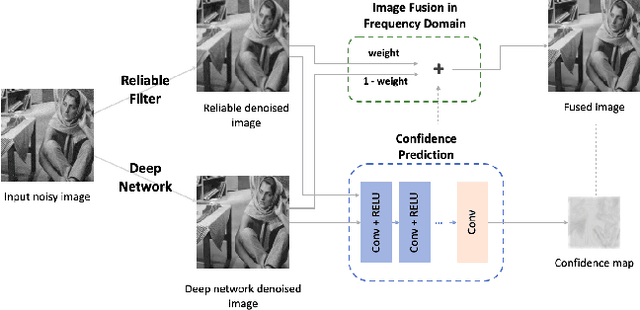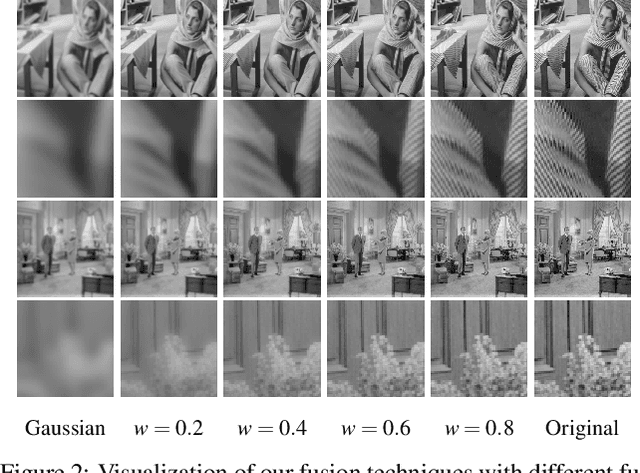Majed El Helou
Facial Image Feature Analysis and its Specialization for Fréchet Distance and Neighborhoods
Jun 26, 2024Abstract:Assessing distances between images and image datasets is a fundamental task in vision-based research. It is a challenging open problem in the literature and despite the criticism it receives, the most ubiquitous method remains the Fr\'echet Inception Distance. The Inception network is trained on a specific labeled dataset, ImageNet, which has caused the core of its criticism in the most recent research. Improvements were shown by moving to self-supervision learning over ImageNet, leaving the training data domain as an open question. We make that last leap and provide the first analysis on domain-specific feature training and its effects on feature distance, on the widely-researched facial image domain. We provide our findings and insights on this domain specialization for Fr\'echet distance and image neighborhoods, supported by extensive experiments and in-depth user studies.
Which Information Matters? Dissecting Human-written Multi-document Summaries with Partial Information Decomposition
May 23, 2024Abstract:Understanding the nature of high-quality summaries is crucial to further improve the performance of multi-document summarization. We propose an approach to characterize human-written summaries using partial information decomposition, which decomposes the mutual information provided by all source documents into union, redundancy, synergy, and unique information. Our empirical analysis on different MDS datasets shows that there is a direct dependency between the number of sources and their contribution to the summary.
VerA: Versatile Anonymization Fit for Clinical Facial Images
Dec 04, 2023Abstract:The escalating legislative demand for data privacy in facial image dissemination has underscored the significance of image anonymization. Recent advancements in the field surpass traditional pixelation or blur methods, yet they predominantly address regular single images. This leaves clinical image anonymization -- a necessity for illustrating medical interventions -- largely unaddressed. We present VerA, a versatile facial image anonymization that is fit for clinical facial images where: (1) certain semantic areas must be preserved to show medical intervention results, and (2) anonymizing image pairs is crucial for showing before-and-after results. VerA outperforms or is on par with state-of-the-art methods in de-identification and photorealism for regular images. In addition, we validate our results on paired anonymization, and on the anonymization of both single and paired clinical images with extensive quantitative and qualitative evaluation.
Fuzzy-Conditioned Diffusion and Diffusion Projection Attention Applied to Facial Image Correction
Jul 01, 2023Abstract:Image diffusion has recently shown remarkable performance in image synthesis and implicitly as an image prior. Such a prior has been used with conditioning to solve the inpainting problem, but only supporting binary user-based conditioning. We derive a fuzzy-conditioned diffusion, where implicit diffusion priors can be exploited with controllable strength. Our fuzzy conditioning can be applied pixel-wise, enabling the modification of different image components to varying degrees. Additionally, we propose an application to facial image correction, where we combine our fuzzy-conditioned diffusion with diffusion-derived attention maps. Our map estimates the degree of anomaly, and we obtain it by projecting on the diffusion space. We show how our approach also leads to interpretable and autonomous facial image correction.
PoGaIN: Poisson-Gaussian Image Noise Modeling from Paired Samples
Oct 10, 2022



Abstract:Image noise can often be accurately fitted to a Poisson-Gaussian distribution. However, estimating the distribution parameters from only a noisy image is a challenging task. Here, we study the case when paired noisy and noise-free samples are available. No method is currently available to exploit the noise-free information, which holds the promise of achieving more accurate estimates. To fill this gap, we derive a novel, cumulant-based, approach for Poisson-Gaussian noise modeling from paired image samples. We show its improved performance over different baselines with special emphasis on MSE, effect of outliers, image dependence and bias, and additionally derive the log-likelihood function for further insight and discuss real-world applicability.
DSR: Towards Drone Image Super-Resolution
Aug 25, 2022



Abstract:Despite achieving remarkable progress in recent years, single-image super-resolution methods are developed with several limitations. Specifically, they are trained on fixed content domains with certain degradations (whether synthetic or real). The priors they learn are prone to overfitting the training configuration. Therefore, the generalization to novel domains such as drone top view data, and across altitudes, is currently unknown. Nonetheless, pairing drones with proper image super-resolution is of great value. It would enable drones to fly higher covering larger fields of view, while maintaining a high image quality. To answer these questions and pave the way towards drone image super-resolution, we explore this application with particular focus on the single-image case. We propose a novel drone image dataset, with scenes captured at low and high resolutions, and across a span of altitudes. Our results show that off-the-shelf state-of-the-art networks witness a significant drop in performance on this different domain. We additionally show that simple fine-tuning, and incorporating altitude awareness into the network's architecture, both improve the reconstruction performance.
Image Denoising with Control over Deep Network Hallucination
Jan 02, 2022



Abstract:Deep image denoisers achieve state-of-the-art results but with a hidden cost. As witnessed in recent literature, these deep networks are capable of overfitting their training distributions, causing inaccurate hallucinations to be added to the output and generalizing poorly to varying data. For better control and interpretability over a deep denoiser, we propose a novel framework exploiting a denoising network. We call it controllable confidence-based image denoising (CCID). In this framework, we exploit the outputs of a deep denoising network alongside an image convolved with a reliable filter. Such a filter can be a simple convolution kernel which does not risk adding hallucinated information. We propose to fuse the two components with a frequency-domain approach that takes into account the reliability of the deep network outputs. With our framework, the user can control the fusion of the two components in the frequency domain. We also provide a user-friendly map estimating spatially the confidence in the output that potentially contains network hallucination. Results show that our CCID not only provides more interpretability and control, but can even outperform both the quantitative performance of the deep denoiser and that of the reliable filter, especially when the test data diverge from the training data.
Fidelity Estimation Improves Noisy-Image Classification with Pretrained Networks
Jun 01, 2021



Abstract:Image classification has significantly improved using deep learning. This is mainly due to convolutional neural networks (CNNs) that are capable of learning rich feature extractors from large datasets. However, most deep learning classification methods are trained on clean images and are not robust when handling noisy ones, even if a restoration preprocessing step is applied. While novel methods address this problem, they rely on modified feature extractors and thus necessitate retraining. We instead propose a method that can be applied on a pretrained classifier. Our method exploits a fidelity map estimate that is fused into the internal representations of the feature extractor, thereby guiding the attention of the network and making it more robust to noisy data. We improve the noisy-image classification (NIC) results by significantly large margins, especially at high noise levels, and come close to the fully retrained approaches. Furthermore, as proof of concept, we show that when using our oracle fidelity map we even outperform the fully retrained methods, whether trained on noisy or restored images.
NTIRE 2021 Depth Guided Image Relighting Challenge
Apr 27, 2021



Abstract:Image relighting is attracting increasing interest due to its various applications. From a research perspective, image relighting can be exploited to conduct both image normalization for domain adaptation, and also for data augmentation. It also has multiple direct uses for photo montage and aesthetic enhancement. In this paper, we review the NTIRE 2021 depth guided image relighting challenge. We rely on the VIDIT dataset for each of our two challenge tracks, including depth information. The first track is on one-to-one relighting where the goal is to transform the illumination setup of an input image (color temperature and light source position) to the target illumination setup. In the second track, the any-to-any relighting challenge, the objective is to transform the illumination settings of the input image to match those of another guide image, similar to style transfer. In both tracks, participants were given depth information about the captured scenes. We had nearly 250 registered participants, leading to 18 confirmed team submissions in the final competition stage. The competitions, methods, and final results are presented in this paper.
* Code and data available on https://github.com/majedelhelou/VIDIT
Deep Gaussian Denoiser Epistemic Uncertainty and Decoupled Dual-Attention Fusion
Jan 22, 2021



Abstract:Following the performance breakthrough of denoising networks, improvements have come chiefly through novel architecture designs and increased depth. While novel denoising networks were designed for real images coming from different distributions, or for specific applications, comparatively small improvement was achieved on Gaussian denoising. The denoising solutions suffer from epistemic uncertainty that can limit further advancements. This uncertainty is traditionally mitigated through different ensemble approaches. However, such ensembles are prohibitively costly with deep networks, which are already large in size. Our work focuses on pushing the performance limits of state-of-the-art methods on Gaussian denoising. We propose a model-agnostic approach for reducing epistemic uncertainty while using only a single pretrained network. We achieve this by tapping into the epistemic uncertainty through augmented and frequency-manipulated images to obtain denoised images with varying error. We propose an ensemble method with two decoupled attention paths, over the pixel domain and over that of our different manipulations, to learn the final fusion. Our results significantly improve over the state-of-the-art baselines and across varying noise levels.
 Add to Chrome
Add to Chrome Add to Firefox
Add to Firefox Add to Edge
Add to Edge